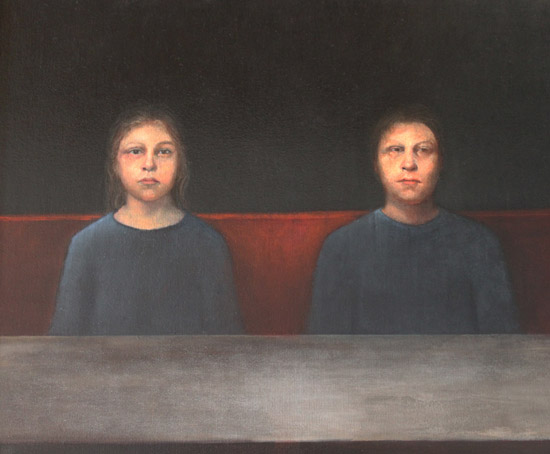
Under the Influence: A Dialogue in Art
by Gabrielle Selz
June 30th, 2014
“Art is a means of communication,” Leo Tolstoy declared in 1896. Expanding on this idea, he went on to state that art is an experience that the artist shares with the viewer.
Though Tolstoy focused on the connection between artist and a larger society, the importance of transmission between one artist and another artist is implicit in his statement. Influences are complex, involving layers of meaning, conversations, images viewed and skills learned, but in one form or another, all artists (save perhaps those fringe, Art Brut characters and the completely untrained) are conversing with their predecessors and contemporaries. “Under the Influence,” a show curated by Peter J. Marcelle and on view at the Sag Harbor Whaling Museum until July 8, explores the relationship between nine contemporary artists and the artists who inspired them.
The exhibition, in the Greek Revival front parlor of the historic Whaling Museum, covers every inch of wall space, including even the doors in a bit of a helter-skelter arrangement. Many of the connections of influence are obvious. Terry Elkins’s Hendrickson House, a one-point perspective oil painting of a front porch done in muted grays, links directly to the sea-infused watercolor by Andrew Wyeth, Sail Loft. Both these painters present formal renditions of architectural structures from similar vantage points; both are as much about weather as they are about humanizing edifices.
.

.

.
Dan Rizzie’s mixed-media collage, Mondrian Vase, is a black cutout jug of flowers over a decorative geometric patterned background. Up above, Donald Sultan—in this case the inspiration—who is known for his strong, large-scale still life paintings of natural imagery, is represented by a velvety charcoal silhouette, Black Roses, Aug, 1989.
Sultan’s fragile yet striking stem of flowers appears to float across the white surface of the paper. Again, each artist is concerned with presenting bold natural imagery, in each case in a flattened format that renders the forms nearly abstract.
.

.
A curious coupling is a photograph by Alfred Stieglitz with one by Stephen Schaub. Stieglitz earned fame as an early promoter of Modern Art and was also one of the first to embrace photography as an art medium, elevating its status to the level of painting. Like many of his photos, Spring Showers is a low contrast image in which the weather dominates, leaving the central subject in the background and out of focus. It’s a perfect balance between softness and definition.
In the past, Schaub has created soft-focused imagery with a distinctly grainy, 19th century feel. Here he is represented by a vibrantly colored and saturated photo, Fried Dough, of a woman in a food kiosk. It’s hard to understand why Marcelle chose this small but intense work to pair with the Stieglitz. Perhaps it’s because both artists work with isolated figures, portraying unresolved moments. Indeed, many of Schaub’s photographs have incorporated both the gritty texture and the capturing of anonymous narratives that Stieglitz’s work exemplified.
.

.

.
There’s a haunting double portrait by a young artist, Mike Viera, Happy Hour, which is anything but happy. Two grim faces stare out at the viewer, their light-filled faces contrasted against a dark backdrop. Viera studied with Eric Fischl, who is also represented in the show, and the mood of Viera’s work owes a debt to the melancholy and stark series of Rome paintings Fischl produced in the 1990s.
.

.
Steve Miller admits to many influences, but Andy Warhol is clearly a forerunner. Miller often mixes his fascination with science and technology into his art. He distorts scale in unexpected ways and his vocabulary of images range from the abstract to diagraming the natural world. He is a master of process, as seen in his layering of photographs, drawings, silk-screen and text.
In Roger Vivier, red, Miller has silk-screened a pair of the French designer’s stilettos. The decadent choice of spiked high-heeled shoes is homage both to Warhol’s process and his whimsical early drawings of shoes for which he gained fame. Miller’s fashion statement is an X-ray, so that, unlike Warhol, he doesn’t fetishize the object so much as he reveals the mechanics, the nails and pins that hold it together.
.

.
The show, aptly titled, demonstrates how greatly artists influence each other. Often art is not just a conversation, but also a dialogue with the past, with history and the artists who came before. Each generation absorbs or discards the impact of prior styles as it climbs up the scaffolding of the preceding one.
